
21 minute read
by Susan F. Beegal
The Young Boy and the Sea: Ernest Hemingway's Visit to Nantucket Island
by
Susan F. Beegal University of Massachusetts, Nantucket Field Station
THE NAME ERNEST Hemingway is synonymous in American literature with islands, the ocean, and deep-sea fishing. One thinks of Key West, with its rum-runners and smugglers, so prominently featured in To Have and Have Not; of Bimini, where Thomas Hudson and his sons hunt swordfish in Islands in the Stream; and most of all Cuba, where the old fisherman Santiago fights his lonely, losing battle with a giant marlin. So ascendant are these Caribbean isles, waters, and monster fish in Hemingway's fiction that few people realize his lifelong romance with the sea began off the coast of New England, on Nantucket Island. Nantucket was the first island Hemingway set foot on, Nantucket Sound the first salt water he sailed on, Nantucket sea bass and mackerel the first marine fish he caught. It was on Nantucket that Hemingway first met an old fisherman with a yarn to spin about catching a swordfish, and his trip to Nantucket that inspired his very first short story. He was eleven years old.
Hemingway was born and raised far from the sea in a suburb of Chicago: Oak Park, Illinois. His father, Dr. Clarence Edmonds Hemingway, was also born in Oak Park, and Ernest's mother, Grace Hall Hemingway, in Chicago. But although a Midwesterner by birth, Grace Hemingway had inherited a love of the sea through her English grandfather, Captain Alexander Hancock of the five-masted schooner Elizabeth. When his wife died in 1853, Captain Hancock took his three young children and three hundred passengers bound for the Australia gold rush around Cape Horn to Sydney (2). Captain Hancock disliked Australia, and soon took his children to the United States, where they settled in Dyersville, Iowa (2). Nevertheless, the voyage of the Elizabeth left a lasting impression on Captain Hancock's descendants. His son Benjamin, Grace Hemingway's uncle, would fill the heads of his niece and her children with stories of that dimly remembered cruise, and Captain Hancock's daughter Caroline, Grace's mother, would insist on taking her own children away from Iowa to Nantucket Island, for summers by the sea.
20
HISTORIC NANTUCKET
Grace Hemingway remembered those childhood summers on Nantucket fondly, and wanted her own children to see the ocean and learn more about their Hancock heritage. She also longed for a vacation from the combined cares of raising a large brood of children and teaching music in Oak Park. Unfortunately her husband, a hardworking doctor, could not leave his practice for long trips, nor supervise all of his children without hired help while his wife was away on a pleasure jaunt. Of necessity, Grace's trips to the sea must be infrequent. Finally she hit upon a scheme. Each year that one of her children turned eleven, Grace and that child would travel east for a month alone together on Nantucket Island. In this way she hoped not only to get to know her children as individuals by having them alone for awhile, but also to see "dear old Nantucket" again.
Ernest's turn to visit Nantucket came in September, 1910. Mother and son embarked for the island from Woods Hole, where the ferry put in to collect passengers from the Boston train. They steamed across Vineyard Sound to dock briefly at Oak Bluffs on Martha's Vineyard, then began the last leg of the voyage to Nantucket. W.B.R. Mason, editor of the Bound Brook, New Jersey Chronicle, has described what it was like to enter Nantucket Harbor in 1910. One must imagine young Ernest Hemingway and his mother standing on the deck of the ferry, straining to catch their first glimpse of the town, as tourists still do today:

...the town of Nantucket is sighted, beautifully situated on a slope rising from the harbor to a considerable elevation in the residence section. Prominent objects on the hill, outlined against the sky, are the Unitarian and Congregational Churches, the Sea Cliff Hotel, and the old Windmill that ground the corn of the natives many years ago (ll).
Once disembarked from the ferry, the Hemingways made their way to Miss Annie Ayers' guest house at 45 Pearl Street. Pearl Street is now India Street, and while the Ayers Guest House still operates on Union Street, the original was destroyed by fire long ago when a careless guest left a cigarette burning downstairs (15). However, in 1910, Ernest and his mother were welcomed to a traditional Nantucket home then over a hundred years old (14). The ceilings were just six feet high, and Mrs. Hemingway would "hit the ceiling regularly on the upward strokes of her brush as she dressed her long hair every morning." (14). Miss Ayers' guest house was "beautifully kept," and the company congenial (15). Grace wrote to her husband that there were "many good people" in the house (6). Certainly she enjoyed her hostess: Grace Hemingway and Annie Ayers were both fervent suffragettes, Miss
22
HISTORIC NANTUCKET
Ayers holding suffragette meetings in her parlor (14). Ernest found a little girl named Katherine Lucy to play with, and when he caught a Spanish mackerel, Miss Ayers flattered Ernest by cooking it and serving it to her guests for dinner (6).
Almost as soon as he arrived on Nantucket, Ernest went for his first swim in the ocean. Grace was delighted by her son's "wild yells of joy" and his "Wow! What a surf!" (9). Grace ventured into the water at least once, clad in long black stockings, black canvas shoes, a bathing suit with sleeves to the elbows and skirts over the knee-length bloomers, and a floppy cotton bathing cap with wide ruffles around the brim (14). Yet despite all this clothing, proper swimming attire for ladies in 1910, Grace found the September waters too cold. Ernest continued to swim in the sea almost daily, but his mother repaired instead to Hayden's Salt Water Baths. There, in a large building now the Easy Street Gallery, Mr. and Mrs. Hayden pumped sea water into heated tanks when the tide was high so that customers like Mrs. Hemingway could luxuriate in hot salt water baths (15). Years later, Ernest would recall the swimming on Nantucket, reminiscing to his mother about the time when "I'd go in with the kelp and the horseshoe crabs, and you'd s w im i n s alt wa t e r b a th s. ( i 4 ).
When mother and son were not swimming, they were sailing, chartering local catboats to take them out to fish. Writing to one of his little sisters, Ernest boastfully claimed that he had sailed fourteen miles "up to Great Point," a boyish exaggeration of the actual distance, and reported that the water was "fine and rough" (9). These sailing trips were an enormous concession on Grace's part to her son's enthusiasm for the sea. The previous year, visiting Nantucket Island with her eldest daughter Marcelline, Grace had vetoed all sailing parties. Grace explained that when she was a girl four young people, two of them her first cousins, had been drowned at Nantucket when their sailboat capsized (14). Yet if Grace had misgivings about the safety of sailing, she swallowed her fears to take her son fishing.

Another vacation treat for Ernest was a visit to the whaling exhibit at Nantucket's Fair Street Museum (6). There Ernest admired portraits of whaling captains looking very like his seafaring greatgrandfather Alexander Hancock. Always interested in fishing, he doubtless enjoyed fingering the rack of harpoons on the wall. But the best of all was the toothy jaw of a giant sperm whale, towering over the boy and jutting into the open second story of the Fair Street rooms (12). Perhaps the eleven-year-old Hemingway stood in the enormous arch of the whale's jaw and contemplated the ease with which such a monster might have gulped him down. Back in Illinois, Ernest had enjoyed trips to the University of Chicago's Field Museum to admire the dinosaur skeletons (14). How thrilled he must have been to learn that giant
A s p e r m w h a l e ' s j a w , o n e o f t h e n o t a b l e e x h i b i t s a t t h e W h a l i n g M u s e u m o f N a n t u c k e t .

24
HISTORIC NANTUCKET
beasts the size of dinosaurs still swam the seven seas, and that brave men still hunted them from small boats. The boy who loved the Fair Street Museum's whaling exhibit would grow up to fish with rod and reel for huge black marlin weighing over a thousand pounds (3), and rival Melville's whaling saga Moby Dick with a fish story of his own The Old Man and the Sea.
Perhaps Hemingway remembered lessons learned on Nantucket when, in October 1934, a pod of sperm whales surfaced near his fishing boat off Havana. Certainly he could not resist this opportunity to try and harpoon a whale himself:
...Carlos kept shouting, "A whale is worth a fortune in La Habana! A whale is worth a capital for life!" "God bless the Whale!" Enrique would shout. "Death to the whale!" yelled Lopez Mendez. The Maestro was shaking with excitement.
There, a little way ahead, was the whale. He was very impressive. He would swim a little way under water then his broad back would come out and he would go along with the slanted top of his back out, seemingly unconcerned, but when we speeded up the engine to come up on him close enough to fire the harpoon into him he would submerge. We tried coming up on him from the back, but he would go down each time before we were in range. Then we tried coming up on him from an angle, but down he would go again to be out of sight, only to reappear ahead of us, varying his course very little. Time after time we came within thirty feet of him only to have him go down. The speeding up of the motors seemed to frighten him and put him down and only by speeding up the motors could we come up on him. He was about forty feet long and as we came up close to him we could see the indentations along the side of his blunt head running back toward the body, as though someone had made them by rubbing a finger in warm wax. Again and again we were so close to him you could have hit him with a beer bottle, but I knew for the harpoon to hold we should be almost touching him with the boat when fired.
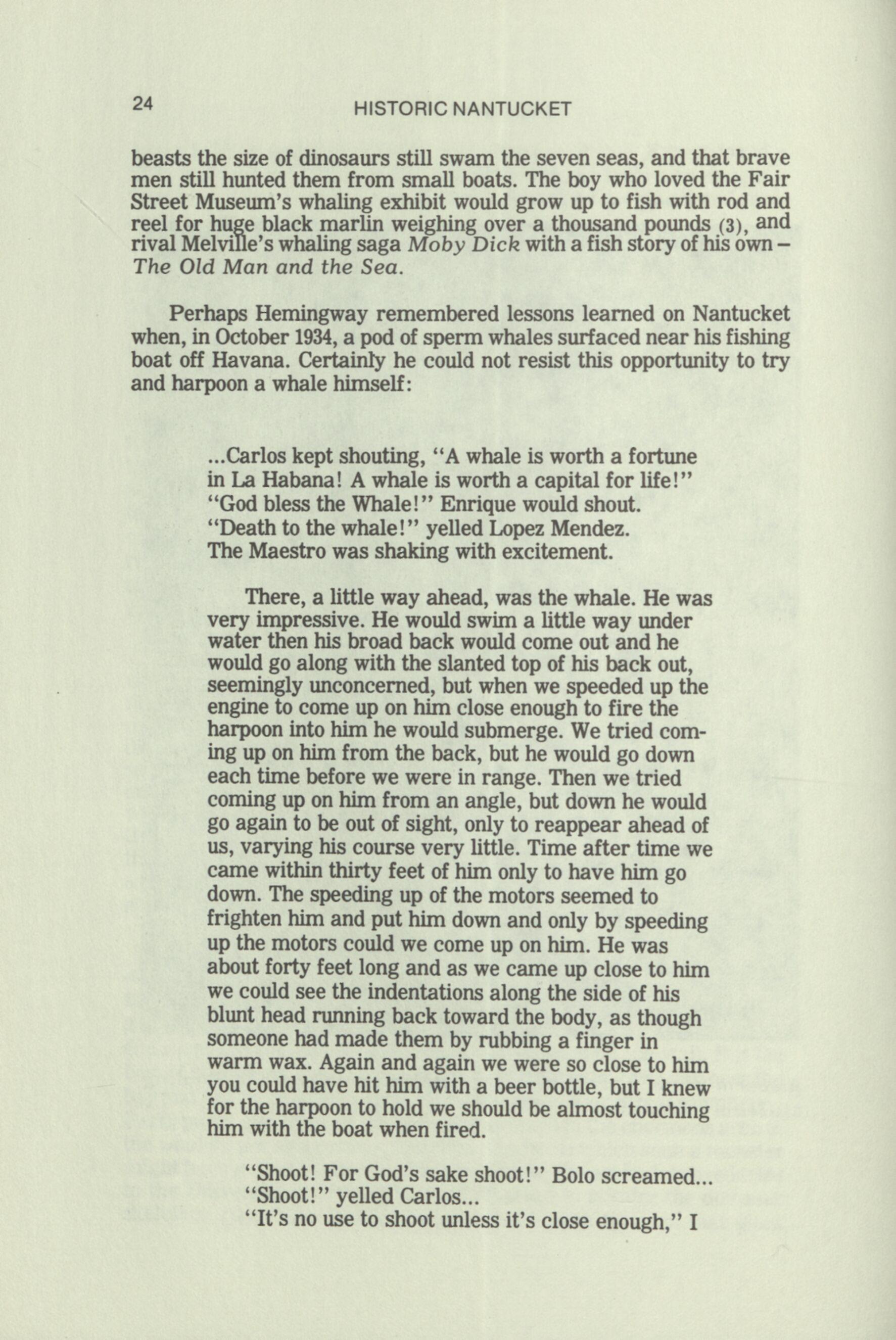
"Shoot! For God's sake shoot!" Bolo screamed... "Shoot!" yelled Carlos... "It's no use to shoot unless it's close enough," I
E R N E S T H EMIN G W A Y A N D N A NT U CK E T
yelled back. "The gun can't carry the weight of that hawser." ...The next time we came close and they began yelling to shoot, I said "All right. I'll show you what I mean," and fired when we were not quite thirty feet from the whale and he had lowered his head to sound. The blackpowder roared, the wire shot out, came taut with the weight of the hawser, and the dart was short. The whale went down and this time he came up a long way ahead and it was hard to see him in the sun.(5) 25
Not every boy has the opportunity to enact in adulthood fantasies conceived in a Nantucket whaling exhibit, but Ernest Hemingway was a notable exception to that general rule.
Around the 16th and 17th of September, the midst of the Hemingways' visit and hurricane season, a storm arose that kept mother and son from swimming and sailing. Undaunted, they walked across the moors to Surfside. Here they watched the storm breakers roll in, and toured the Surfside Lifesaving Station. Grace and Ernest doubtless inspected the Lyle gun that fired a breeches buoy out to a foundering ship, and the lifeboat-on-wheels that strong horses would drive down the beach for launching into the surf (i6). Ernest must have been deeply interested to learn about the professional heroes of the Surfside Lifesaving Station. Throughout his life, Hemingway remained fascinated by men - bullfighters, boxers, soldiers - who risked their lives to earn their pay.
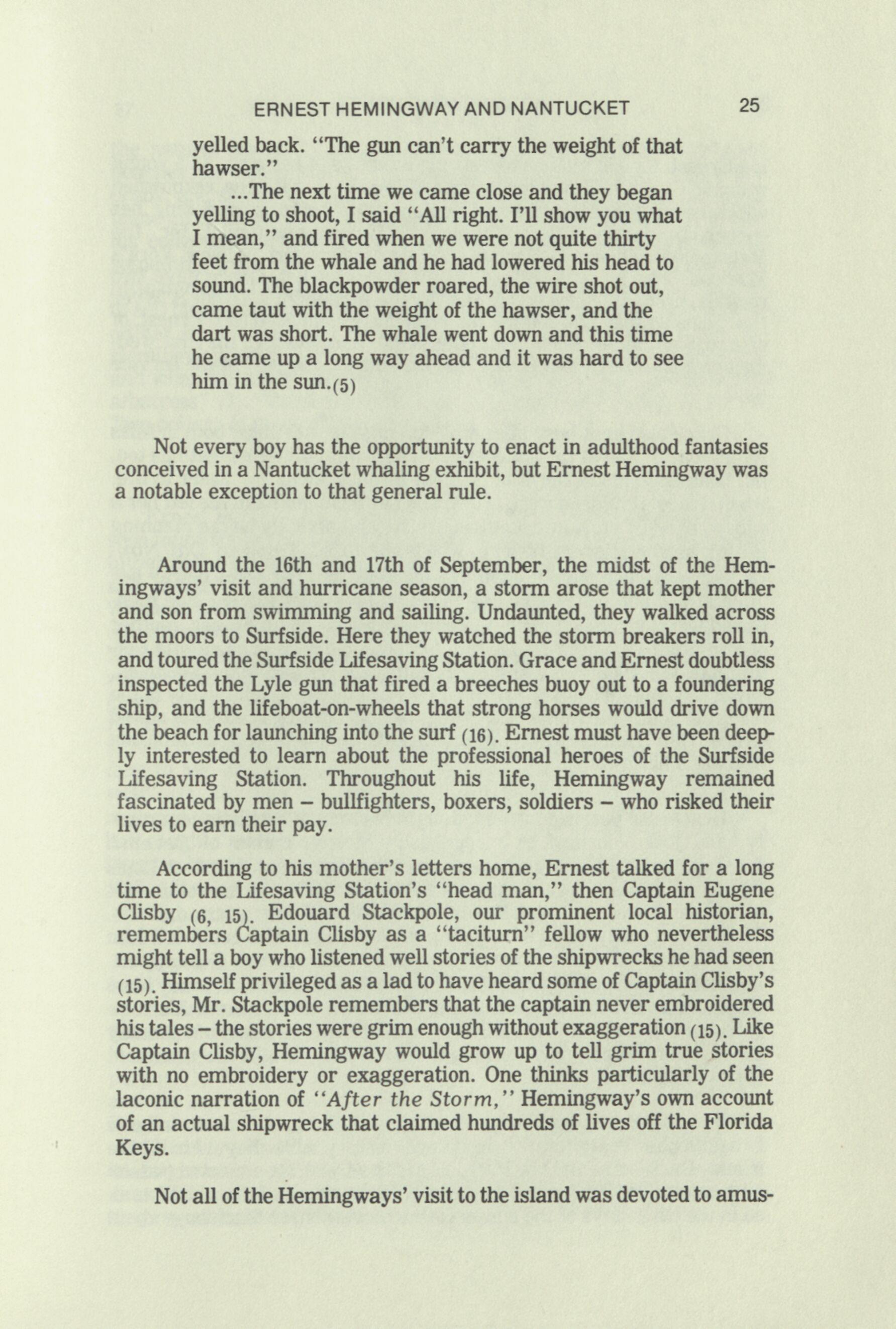
According to his mother's letters home, Ernest talked for a long time to the Lifesaving Station's "head man," then Captain Eugene Clisby (6, 15). Edouard Stackpole, our prominent local historian, remembers Captain Clisby as a "taciturn" fellow who nevertheless might tell a boy who listened well stories of the shipwrecks he had seen (15). Himself privileged as a lad to have heard some of Captain Clisby's stories, Mr. Stackpole remembers that the captain never embroidered his tales - the stories were grim enough without exaggeration (15). Like Captain Clisby, Hemingway would grow up to tell grim true stories with no embroidery or exaggeration. One thinks particularly of the laconic narration of "After the Storm," Hemingway's own account of an actual shipwreck that claimed hundreds of lives off the Florida Keys.
Not all of the Hemingways' visit to the island was devoted to amus-
26
HISTORIC NANTUCKET
ing Ernest, for his mother had strong interests of her own. As a young woman, Grace had studied voice in New York with the reknowned opera coach Madame Louisa Cappiani (10). Before abandoning her career to marry Dr. Hemingway, Grace auditioned for the Metropolitan Opera and gave a successful concert at New York's Madison Square Garden (io). In 1910 on Nantucket, Grace gave two recitals, probably arranged for her by the Atheneum's Arthur S. Wyer (15). She also sang solos in the choir during her girlhood (14). Ernest, of course, went along when his mother sang, and attended his first wedding on Nantucket when Grace performed a solo as part of the service (7).
Grace also kept busy attending suffragette meetings, both in Miss Ayers' parlor and at the Atheneum. Ernest went to these meetings too, but boasted to his father that he slept through them (9). Later in life, when Grace's children were grown and her husband's suicide left her a widow, she visited Nantucket frequently, and actually began planning a b o o k o n t he i s lan d 's h is t o r y, wh i c h s he t i t led T a l e s o f O l d N a n tucket (8). Grace did not complete the book, but her notes betray her interest in Nantucket's strong-minded and feminist women. She mentioned Keziah Folger Coffin, the entrepreneur; Abiah Folger, mother of Benjamin Franklin; Maria Mitchell, the astronomer; Lucretia Coffin Mott, the abolitionist and suffragette leader; and Mary Starbuck, one of the leading Quaker preachers of her day (8). Traditionally in the forefront of any movement involving women's rights, Nantucket suited Grace Hall Hemingway, an intelligent, talented and dominating woman in her own right.

Grace also pursued introductions in Nantucket's artistic communit y, a n d t ook E a r n i e st t o m ee t Au st i n S t r o n g , a u th o r o f S e v e n t h Heaven and Three Wise Fools, and the grandson of Robert Louis Stevenson's wife (6). The Hemingway home contained a ten volume set of Stevenson's work, which Ernest carried off with him as an adult (13). The boy probably enjoyed meeting a playwright who could tell him a n e c d otes a b o u t t he a u th o r o f T r e a s u r e I s l a n d a n d K i d n a p p e d . Austin Strong reputedly knew how to entertain children, and may have recounted to Ernest his memories of Stevenson on Samoa (15). Certainly Grace was thrilled to meet Strong, recording their interview proudly in her letters home, and returning to visit the playwright on subsequent trips to Nantucket. (8).
In spite of her own busy schedule, Grace found time to indulge Ernest's passionate interest in natural history whle they were on the island. Back home in Oak Park, Ernest had just been elected "assistant curator" of the Agassiz Club, an organization his father had founded in the early days of the conservation movement to teach boys about
27
ERNEST HEMINGWAY AND NANTUCKET
the natural world (7). Now Ernest delighted in combing Nantucket beaches for "specimens," collected "lovely seaweed," horseshoe crabs, and shells (6). Grace complained that her son wanted to bring home all of the shells on Nantucket, but faithfully accompanied him on his collecting expeditions nevertheless (6). Still Ernest yearned for something truly rare and unusual to take back for the Agassiz Club's little museum. On the island's wharves he met a fisherman who offered to sell him an albatross foot for two dollars (6). Prudently, Graced urged her son to write his father about this dubious transaction (7). Dr. Hemingway wrote back that Ernest should secure proof as to where and when the albatross foot was collected and whether it was "a real albatross" (7). "Don't get faked," Dr. Hemingway warned his son(7). Two dollars in those days was a lot of money.
Ernest did not buy the albatross foot, but with his mother's help soon found something better. On September 13,1910, he wrote to tell his father that he had purchased the bill of a large swordfish from an old salt named "Judas" (2). Grace, a leading figure in Oak Park's Women's Christian Temperance Union, also wrote home to say that the old salt was "probably drunk" (6). J. Clinton Andrews, an expert on the history of Nantucket's fishing industry, suspects that Ernest's "Judas" was probably Judah Nickerson, by 1910 an elderly retired fisherman given to gossiping with cronies on the wharves.(1) Mr. Andrews remembers hearing that Judah Nickerson was a "fairly aggressive" fellow, both a good fisherman and a good sailor in his prime (1). According to Mr. Stackpole, Judah did not drink to excess, "but he drank we l l " ( 1 ) . On J u ly 1 6 , 1 8 8 7 , t he Na n t u c k et I n q u i r e r a n d M i r r o r reported that Judah Nickerson, then captain of his own fishing vessel, had caught "a noble swordfish" - an exceptionally large specimen for these waters (17). Perhaps it was the bill of that swordfish Judah sold in 1 9 1 0 t o t he b o y wh o wo u l d g r o w u p t o wr it e O l d M a n a n d t h e S e a .

If young Ernest asked how Judah caught his swordfish, he would have learned how the Nantucket fisherman sailed his catboat silently up to a fish sunning itself on the surface of the water (1). Creeping out to the end of a plank projecting from the bow, Judah would have stabbed his prey with a twelve or fifteen foot harpoon specially made for the purpose(l). When the dart went in, the harpoon pole would detach itself, and the swordfish would plunge away (1). The dart embedded in the fish, however, was attached to a long rope tied to a buoyant keg (1). The air-filled barrel would prevent the wounded swordfish from diving and its drag would tire the animal rapidly. The barrel would also mark the swordfish's whereabouts, making it easier for Judah to locate and gaff his prey when it was thoroughly exhausted.
28
HISTORIC NANTUCKET
Ernest returned sunburned and happy to Oak Park, where he entered the sixth grade (2). There, at Holmes Grammer School, he wrote his first short story in a class exercise:
Mon April 17 1911 MY FIRST SEA VOUGE Ernest H
I was born in a little white house on the Island of Marthas Vineyard in the State of Massachusetts. My mother died when I was four years old and my father, a catain of the three masted schooner "Elizabeth" took me and my little brother around the "Horn" with him to Australia.
Going we had fine weather and we would see the porpoises playing around the ship and the big white albatross winging its way across the ocean or following the brig for scraps of food; the sailors caught one on a huge hook baited with a biscuit but they let him go as soon as they had caught him for they are very superstitious about these big birds.
One time the sailors went out on a barrel fastened to the bow sprit and speared a porpoise (or sea pig as they call them) and hauled him up on deck and we had it fried for supper it tasted like pork only it was greesier.
We arrived in Sydney Australia after a fine vouge and had just as good vouge going back (2).
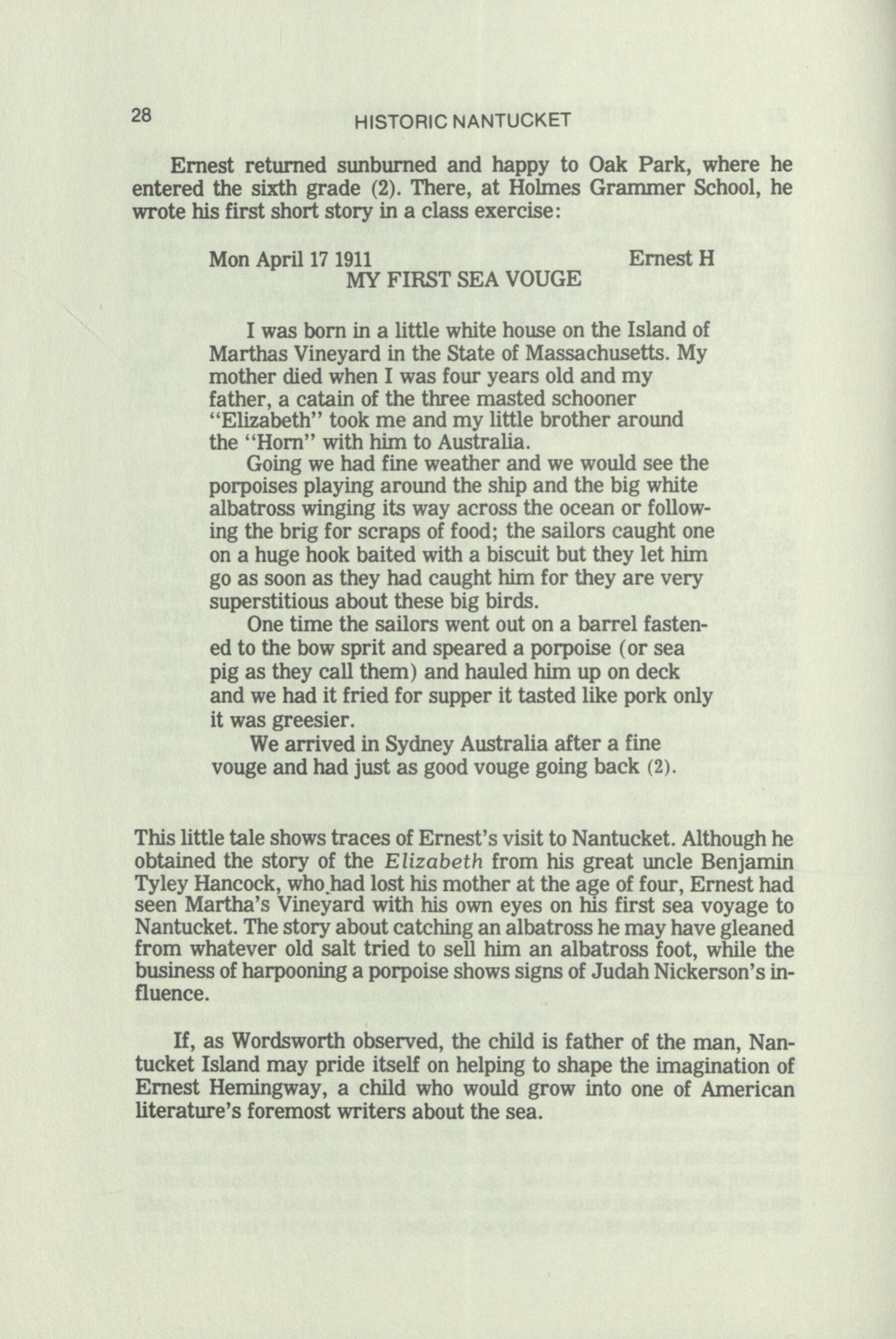
This little tale shows traces of Ernest's visit to Nantucket. Although he obtained the story of the Elizabeth from his great uncle Benjamin Tyley Hancock, who had lost his mother at the age of four, Ernest had seen Martha's Vineyard with his own eyes on his first sea voyage to Nantucket. The story about catching an albatross he may have gleaned from whatever old salt tried to sell him an albatross foot, while the business of harpooning a porpoise shows signs of Judah Nickerson's influence.
If, as Wordsworth observed, the child is father of the man, Nantucket Island may pride itself on helping to shape the imagination of Ernest Hemingway, a child who would grow into one of American literature's foremost writers about the sea.
E R N E S T H EMIN G W A Y A N D N A NT U CK E T 29
LIST OF WORKS CITED
1. Andrews, J. Clinton. Interview with the Author. 30 July 1983.
2. Baker, Carlos. Ernest Hemingway: A Life Story. New York: Avon Books, 1968.
3. Farrington, S. Kip Jr. Fishing with Ernest Hemingway and Glassell. New York:: David McKay Co., 1971.
4. Hemingway, Ernest. Selected Letters 1917 - 1961. Ed. Carlos Baker. New York: Charles Scribners Sons, 1981.
5. "There She Breaches! or, Moby Dick Off The Morro." Esquire, 1936. Rpt. in By-Line: Ernest Hemingway. Ed. William White. New York: Charles Scribners Sons, 1967.
6. Hemingway, Grace Hall to Dr. Clarence Hemingway. 2, 7, 9,11,13, 15,19, 24 September 1910. Humanities Research Center, University of Texas at Austin.
7. Scrapbook IV. John Fitzgerald Kennedy Library. Boston, MA.
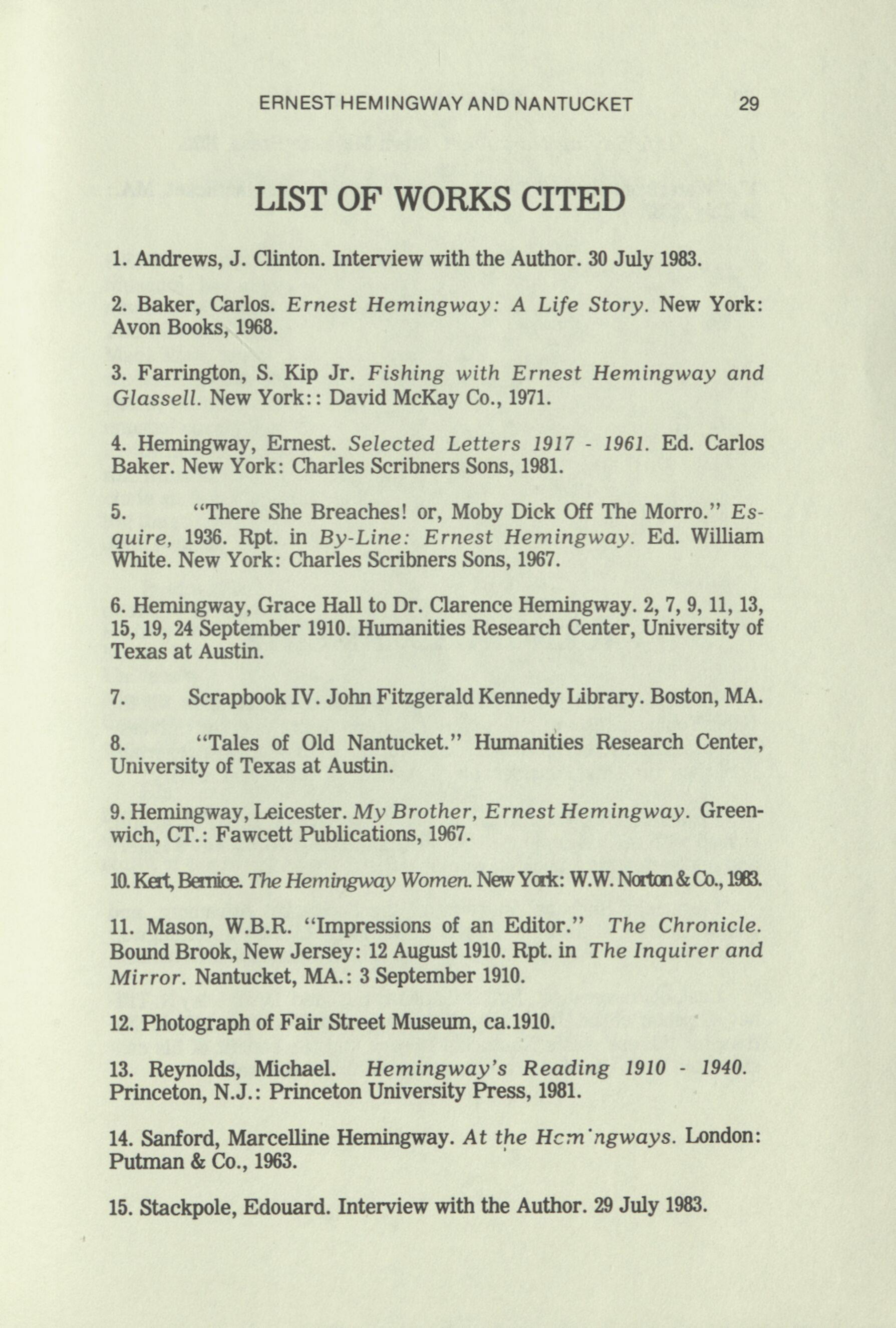
8. "Tales of Old Nantucket." Humanities Research Center, University of Texas at Austin.
9. Hemingway, Leicester. My Brother, Ernest Hemingway. Greenwich, CT.: Fawcett Publications, 1967.
10. Keit, Bemica The Hemingway Women. New Yak: W.W. Natai&Co., 1983.
11. Mason, W.B.R. "Impressions of an Editor." The Chronicle. Bound Brook, New Jersey: 12 August 1910. Rpt. in The Inquirer and Mirror. Nantucket, MA.: 3 September 1910.
12. Photograph of Fair Street Museum, ca.1910.
13. Reynolds, Michael. Hemingway's Reading 1910 - 1940. Princeton, N.J.: Princeton University Press, 1981.
14. Sanford, Marcelline Hemingway. At the Hcm'ngways. London: Putman & Co., 1963.
15. Stackpole, Edouard. Interview with the Author. 29 July 1983.
30 HISTORIC NANTUCKET
16. L i f e S a v i n g N a n t u c k e t . Stern-Majestic Press, 1972.
17. "Waterfront News." The I n q u i r e r a n d M i r r o r . Nantucket, MA.: 16 July, 1887.
ACKNOWLEDGEMENTS
I am particularly indebted to Mr. Edouard A. Stackpole, of the Peter Foulger Museum, and to Mr. J. Clinton Andrews of the University of Massachusetts Nantucket Field Station. Both men gave generously of their time and considerable knowledge of Nantucket history.
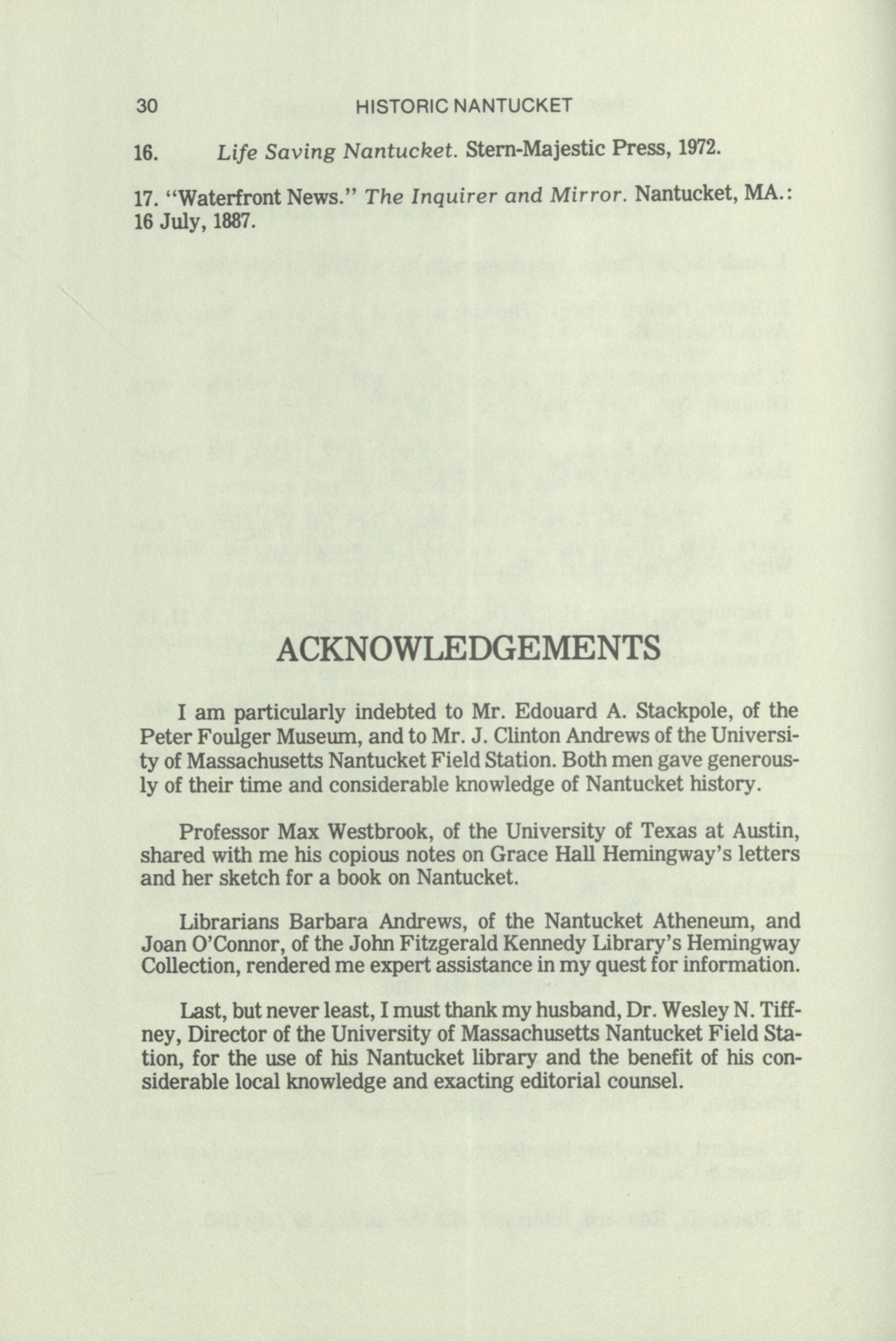
Professor Max Westbrook, of the University of Texas at Austin, shared with me his copious notes on Grace Hall Hemingway's letters and her sketch for a book on Nantucket.
Librarians Barbara Andrews, of the Nantucket Atheneum, and Joan O'Connor, of the John Fitzgerald Kennedy Library's Hemingway Collection, rendered me expert assistance in my quest for information.
Last, but never least, I must thank my husband, Dr. Wesley N. Tiffney, Director of the University of Massachusetts Nantucket Field Station, for the use of his Nantucket library and the benefit of his considerable local knowledge and exacting editorial counsel.








